- A personal study of Daphnia pulex -
- from a hobbyist standpoint -
by
BigC
- from a hobbyist standpoint -
by
BigC
Brief Overview
Daphnia or Waterfleas are a large collection of microcrustacean species from the Order of Cladocera.
Daphnia live for around 40-56 days depending upon the species and environmental conditions. Each female brood consists of anywhere between 2-10 eggs which if conditions are right turn into embryos and are released into the water column within a few days. Juvenile daphnia reach sexual maturity within 6-10 days. A good healthy population of daphnia will almost certainly contain mostly females which have been produced asexually.
Most commonly, females hatch from eggs in the spring; produce females asexually throughout the summer; in the autumn they start producing males, they mate and lay resting eggs. This breeding system is called Cyclic Parthenogenesis
When attempting to culture Daphnia at home it is important to supply your colony's with the correct conditions in-order not to stress the entire culture which will lead to a crash and possible loss. The culture can become stressed if the population density is too high, poor water quality, food shortages and extreme water temperatures. During these times of stress the female will produce more male embryos (which is not what we want) they will begin to re-produce sexually rather than asexually. The female upon mating with a male will expel the resultant eggs which will fall to the substrate and will only hatch (into females) when conditions in the body of water improve and a non stressful environment persists.

Daphnia - Biological Make-Up
Lifecycle
Daphnia has long been celebrated for possessing the power of re-production without the intervention of the male and for laying two different sorts of eggs....CHARLES DARWIN 1857
Under favourable conditions, a female will produce a clutch of eggs after every adult moult, these eggs are placed in a brood chamber which is located dorsally beneath its carapace. The development of these eggs starts immediately. After around 24 hours at a temperature of approximately 20’C the eggs will hatch but remain inside the brood chamber for a further three days, after which time they are released by the mother. The young daphnia resemble their adult counterparts except that the brood chamber will not yet be fully developed. In most species young Daphnia will pass through 4-6 juvenile instars (developmental stages such as moults) before being able to produce eggs for the first time this may take anywhere between 5-10 days at 20’C and can take considerably longer if food is scarce. An adult Daphnia may produce a brood of eggs every 3 to 4 days until she dies. Life expectancy of a female is around 8 weeks and a little longer if food availability is poor. Brood sizes vary considerably and are dependent on the species you are dealing with, they can range from a couple of eggs to over one hundred for the larger species.


i) A group of Daphnia under 200x magnification
ii) A female D. pulex clearly showing 2 developing embryos within her brood chamber.
In a normal growth and breeding cycle, the Daphnia female will produce eggs that will develop directly and be released as live young without a resting phase. When adverse conditions become apparent the female will produce a different type of egg in her brood pouch, this egg is designed for resting only hatching when favourable conditions resume.
These resting eggs are protected and encased in a saddle like structure known as an ephippium.
The ephippium will usually contain 2 large eggs and will be cast off during the next moulting stage. The ephippia can either sink to the bottom or float via means of minute gas chambers, this means that the eggs can either be dispersed by the wind or inadvertently hosted by other animals (i.e. attached to the feathers of waterfowl) for transportation and to populate other water bodies they will only hatch as and when conditions are right, weither this be due to photo-period, temperature, water quality, availability of food or other factors. But from these resting eggs, only females hatch.
I suspect that this is purely Mother Nature’s way of preventing the species of becoming extinct.
Daphnia Home Culturing Method
The Container & Water Conditions;
To get my cultures thriving with a view to releasing them into larger quarters outside, I use 3ltr plastic Ice Cream tubs. Into these I place a small margarine tub filled with coral sand, which helps keep the pH stable.
There are many different angles and formulations out there surrounding the best water conditions for culturing Daphnia, all, I’m sure have valid points. For the purpose of this article I can only deal with what I use, without getting too bogged down in a chemistry lesson. True you don’t want your source water to be loaded with chlorine or heavy pollutants or starved of oxygen. I use rainwater which is adjusted to a pH 7.2 and kept at a temperature (internally) of 72'F.
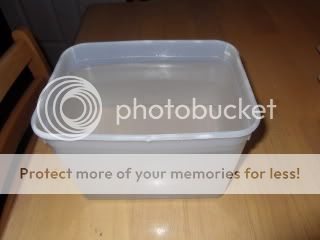

Initial culture vessel, a 3ltr Ice Cream carton. The first thing I needed to do was to adjust the rainwater pH up to 7.2
An airline is placed into the tub and set to a very slow bubble as we don't want heavy aeration because the air can get trapped under the carapace and the Daphnia will be unable to swim and feed properly. Within this environment the Daphnia grow and reproduce quite quickly. There will come a time when, with proper management and feeding the culture will become super saturated. The Daphnia are now ready to be fed to the fish (thinning out) and a 50% water change performed. I have been maintaining these internal cultures for quite some time now, whilst placing some of the surplus stock outside in large barrels. Now with the seasonal climate warming up a little the barrels are now taking over as my prime source of Daphnia on which I use for feeding.All the while still maintaining my internal tubs as infusion resources in case the outside stock should fail.
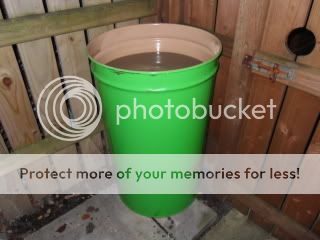
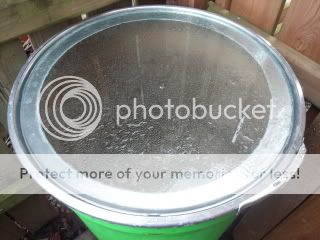
External summer quarters for my Daphnia pulex culture.
Foods & Feeding;
Daphnia are filter feeders and sift the water they live in for amongst other things, bacteria, algae and various particles of debris.
Feeding Daphnia has always been open for debate as many Aquarists offer their own tried and trusted concoctions to satisfy their dietary requirements. I have probably stumbled on a so called elixir of algae (which I culture at home) to feed my colonies on. This method works for me so I see no reason to change. Other folks may have their own potions and possibly gain equal or better results for those methods I cannot comment upon as I can only present my findings from my own practical experiences.
I managed to acquire a starter culture of a strain of algae from a local biologist. As yet I do not have a clue as to the species of algae in question. (Possibly Chlorella Vulgaris)
Basic set-up for culturing this "Green Water" involves (i) having a bright light source close at hand, (ii) the ability to provide turbulence within the culture vessel via aeration, (iii) a reliable food source upon which the algae can assimilate (iv) the culture vessel/s themselves.
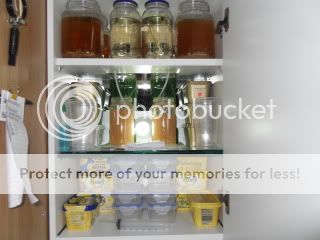
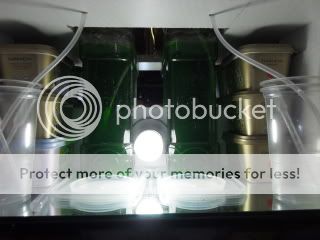
Above images show a cross section of my "Live Food" larder, visible is the "Green Water" algae production
Culture Vessels;
The jars I now use for culturing the algae are made from glass, 2x tall spaghetti jars are now my container of choice. I previously utilised 2ltr Lemonade bottles but they didn't seem to give me the yield that I was seeking. The density of the algae would always be less in a plastic bottle as opposed to glass for some strange reason, perhaps this is due to one of the following reasons, (i) residue from the plastic, (ii) cleanliness or (iii) light dispersion.
Lighting;
Within the cupboard I choose to call my Live Food larder I have incorporated an energy saver light bulb. This has a two fold function (i) it provides light and (ii) it provides a gentle heat source crucial for the development of the many other livefoods contained on the shelves of the cupboard.
The light source is a 15 watt, Daylight spectrum, 6500k energy saver mini twist bulb. This little bulb is excellent for my needs it warms the cupboard to a constant 70'f. It is the single most item on which many lifeforms depend.
Heating;
It is my belief that green algae cultivation needs a certain amount of heat to flourish. I keep the jars at around 68'f provided from a light bulb as mentioned above. This seems to help the algae.
Feeding;
This became an obsession for me at one stage. Trying to find the magic potion that would act as a catalyst to maintaining a thick dark green soup on which I was to feed the Daphnia. After many months of searching, trialling various plant food products and being subjected to failure after failure I wondered if a nutrient enriched food primarily for feeding algae for marine copepod cultivation would work in a freshwater environment. The results were astounding. The product in question was an enhanced version of Guillard's F/2 medium.
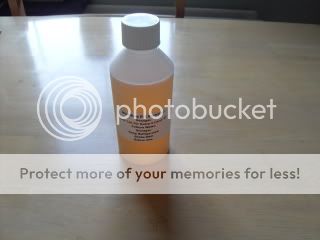
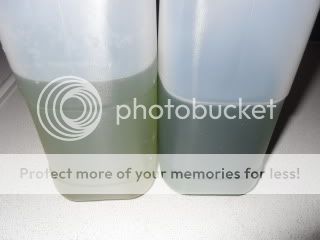
(i)Guillard's F/2 medium. (ii)This image shows two forms of Green Water, the bottle on the left is algae cultured outside whilst the bottle on the right is home artificially cultured algae.
This formulation is now administered at 2ml to 1.5 litres of rainwater. With heavy turbid water and intense lighting the algae will be ready to harvest in around 4 days. After this time lapse I drain of only half of the algae into a well cleaned 2ltr plastic milk carton. I then replenish the original culture vessels with fresh water and add the appropriate amount of food.
Future Developments;
The future for me now is to obtain various species of Daphnia especially the smaller varieties such as Moina (which I have just acquired) and Bosmina longirostris. To try and maintain these in numbers as I have done with D. pulex. I am also currently attempting to culture (long term) Branchinella thailandensis (Thai Fairy Shrimp) utilising similar feeding methods.
Summary;
This has been a labour of love for me to try and get things right, confronted with trials and failures along the way I persevered with the project until it's eventual completion. I can now culture Daphnia in substantial numbers, being able to feed my fish 2-3 times per week and still maintain the colonies. I'm pleased with the results to date, results which I thought were unobtainable at several points.
I hope you enjoyed this lengthy but informative article cataloguing my personal experiences with Daphnia aquaculture. I hope it invites some budding aquarists to give this or similar ventures a go. If writing this article achieves that goal then I feel the time afforded to this this piece of work will have been worth the effort.
All The Best
C
.
